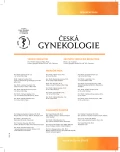Prenatal diagnosis of Noonan syndrome in fetuses with increased nuchal translucency and a normal karyotype
Authors:
M. Matyášová 1; Z. Dobšáková 1; M. Hiemerová 1; J. Kadlecová 1; D. Nikulenkov Grochová 1; E. Popelínská 1; E. Svobodová 1; P. Vlašín 2
Authors‘ workplace:
Cytogenetická laboratoř Brno, s. r. o, vedoucí laboratoře RNDr. E. Popelínská
1; Centrum prenatální diagnostiky Brno, s. r. o, jednatelé MUDr. P. Vlašín a MUDr. M. Čuprová
2
Published in:
Ceska Gynekol 2019; 84(3): 195-200
Category:
Overview
Objective: Noonan syndrome (NS), one of the most common RASopathies, has an estimated incidence of 1 in 1,000–2,500 live births. In the prenatal period increased nuchal translucency, hygroma colli, hydrops fetus, congenital heart disease, kidney defects, larger amount of amniotic fluid can be observed in affected fetuses with this syndrome. In the fetuses with normal karyotype and no microdeletion/microduplication syndromes the examination of selected genes for RASopathies was added. The aim of the study was to evaluate the clinical benefit of massively parallel sequencing (MPS) of susceptible fetal DNA for NS, i.e., the diagnostic yield on the one hand and the proportion of detected variants of unknown significance (VOUS) on the other.
Design: Clinically diagnostic.
Setting: Centrum prenatální diagnostiky, Brno, s.r.o; Cytogenetická laboratoř Brno, s.r.o.
Methods: Samples of amniotic fluid or chorionic villus were analyzed. Selected genes associated with RASopathies were analyzed in case of the negative result of karyotype and array-CGH. A panel of twenty genes was investigated by MPS.
Results: In the two-years period, Noonan syndrome was detected in 10 from 95 investigated fetuses. This represents a 10.5% diagnostic efficiency of the method. DNA variants of unknown significance were detected in 10 fetuses. A segregation analysis helped to clarify their meaning in six fetuses.
Conclusion: MPS allows fast molecular-genetic diagnosis of RASopathies already in the prenatal period. This method contributes to the clarification not only of phenotypic manifestations in already born individuals but also of ultrasound findings in fetuses with both normal karyotype and aCGH.
Keywords:
RASopathies – Noonan syndrome – nuchal translucency – NT – fetal hydrops – cystic hygroma – heart defect – massively parallel sequencing – MPS
Sources
1. Ali, MM., Chasen, ST., Norton, ME. Testing for Noonan syndrome after increased nuchal translucency. Prenatal Diagnosis, 2017, 37, p. 750–753.
2. Aoki, Y., Niihori, T., Inoue, S., Matsubara, Y. Recent advances in RASopathies. J Hum Genet, 2016, 61, p. 33–39.
3. Croonen, EA., Nillesen, WM., Stuurman, KE., et al. Prenatal diagnostic testing of the Noonan syndrome genes in fetuses with abnormal ultrasound findings. Eur J Hum Gen, 2013, 21, p. 936–942.
4. Hernández-Martín, A., Torrelo, A. Rasopathies: developmental disorders that predispose to cancer and skin manifestations. Actas Dermosifiliograf, 2011, 102, p. 402–416.
5. Chen, P., Yin, J., Yu, H., et al. Next-generation sequencing identifies rare variants associated with Noonan syndrome. PNAS, 2014, 111(31), p. 11473–11478.
6. Lee, KA., Williams, B., Roza, K., et al. PTPN11 analysis for the prenatal diagnosis of Noonan syndrome in fetuses with abnormal ultrasound findings. Clin Genet, 2009, 75, p. 190–194.
7. Loucký, J., Springer, D., Zima, T. Možnosti screeningu Downova syndromu v České republice. Čes Gynek, 2008, 73(3), p. 160–162.
8. Milosavljević, D., Overwater E., Tamminga, S., et al. Two cases of RIT1 associated Noonan syndrome: further delineation of the clinical phenotype and review of the literature. AJMG, part A. 2016, p. 1874–1880.
9. OMIM – Online mendelian inheritance in man. [online]. 2018. [cit. 2018-10-15]. Dostupné z: http://www.omim.org/.
10. Rauen, KA. The RASopathies. Ann Rev Genomics. Hum Genet, 2013, 14, p. 355–369.
11. Richards, S., Aziz, N., Bale, S., et al. Standards and guidelines for the interpretation of sequence variants: a joint consensus recommendattion of the American college of medical genetics and genomics and the association for the molecular pathology. Genet Med, 2015, p. 1–20.
12. Sonek, JD., Nicolaides, KH., Janků, P. Screening v 11.–13.+6 týdnu těhotenství. Čes Gynek, 2012, 77(2). p. 92–104.
Labels
Paediatric gynaecology Gynaecology and obstetrics Reproduction medicine Paediatric cardiology Endocrinology Paediatrics General practitioner for children and adolescentsArticle was published in
Czech Gynaecology

2019 Issue 3
Most read in this issue
- Uterine adenomyosis: pathogenesis, diagnostics, symptomatology and treatment
- Echogenic foci in fetal heart from a pediatric cardiologist‘s point of view
- Vaginismus – who takes interest in it?
- Locally advanced colorectal cancer in pregnancy
